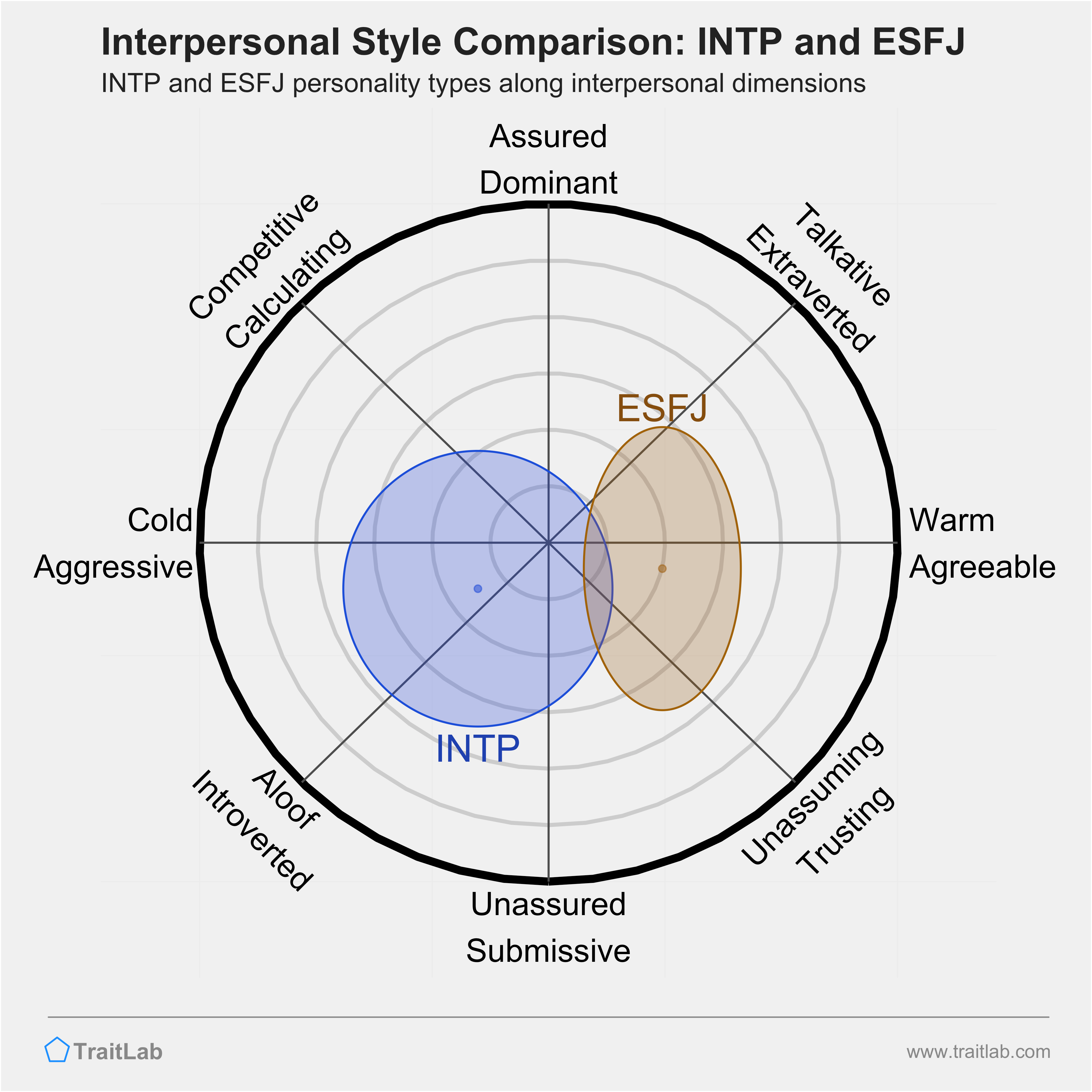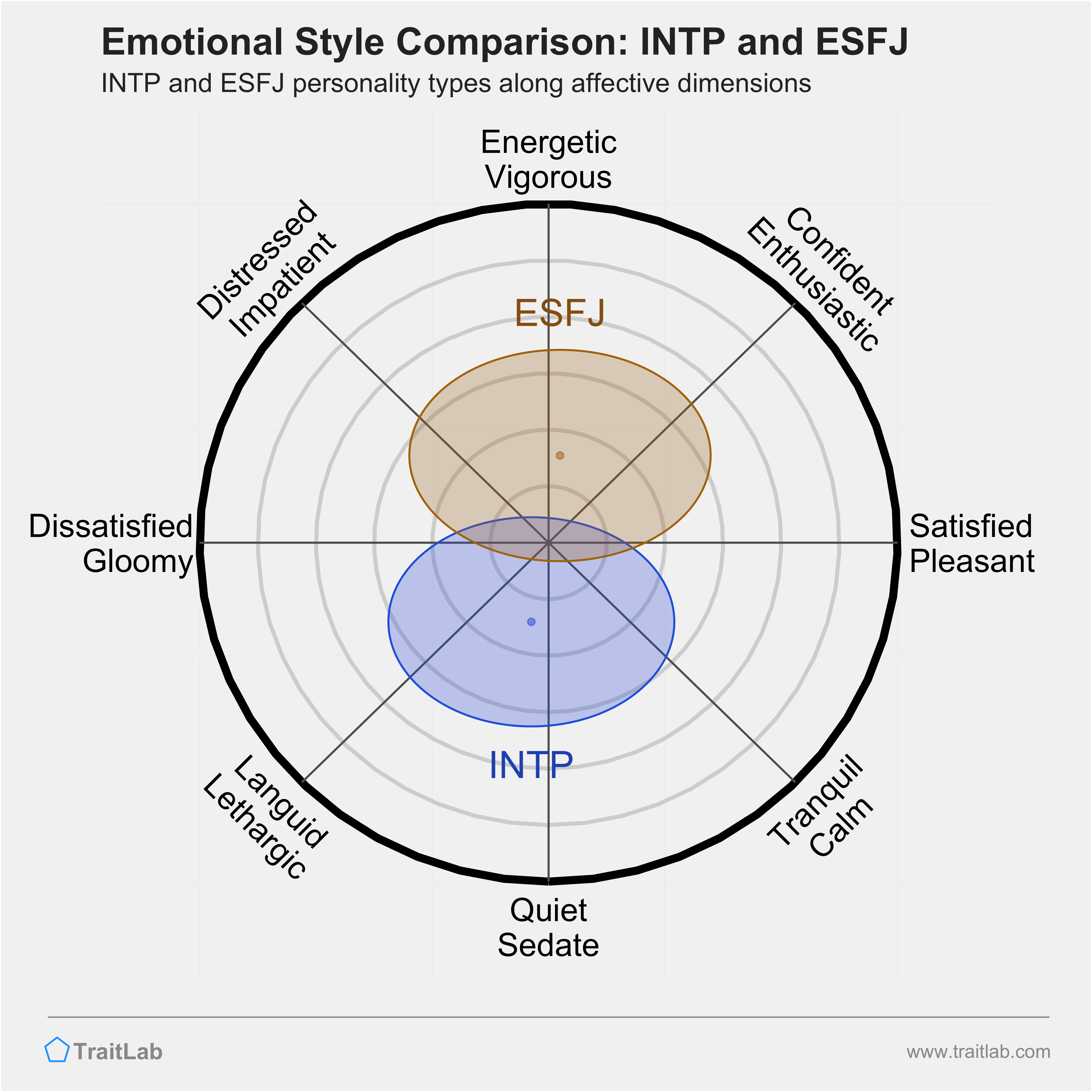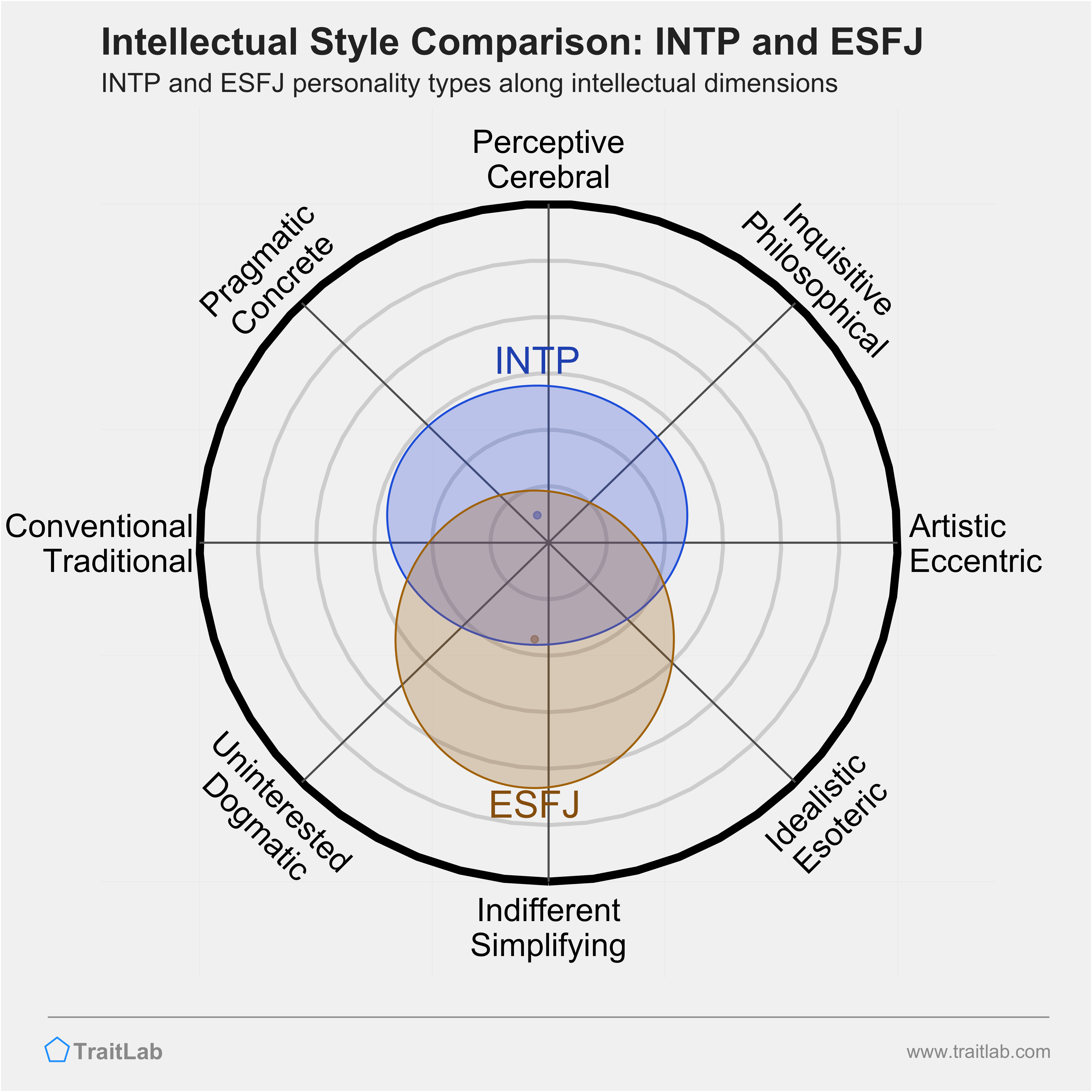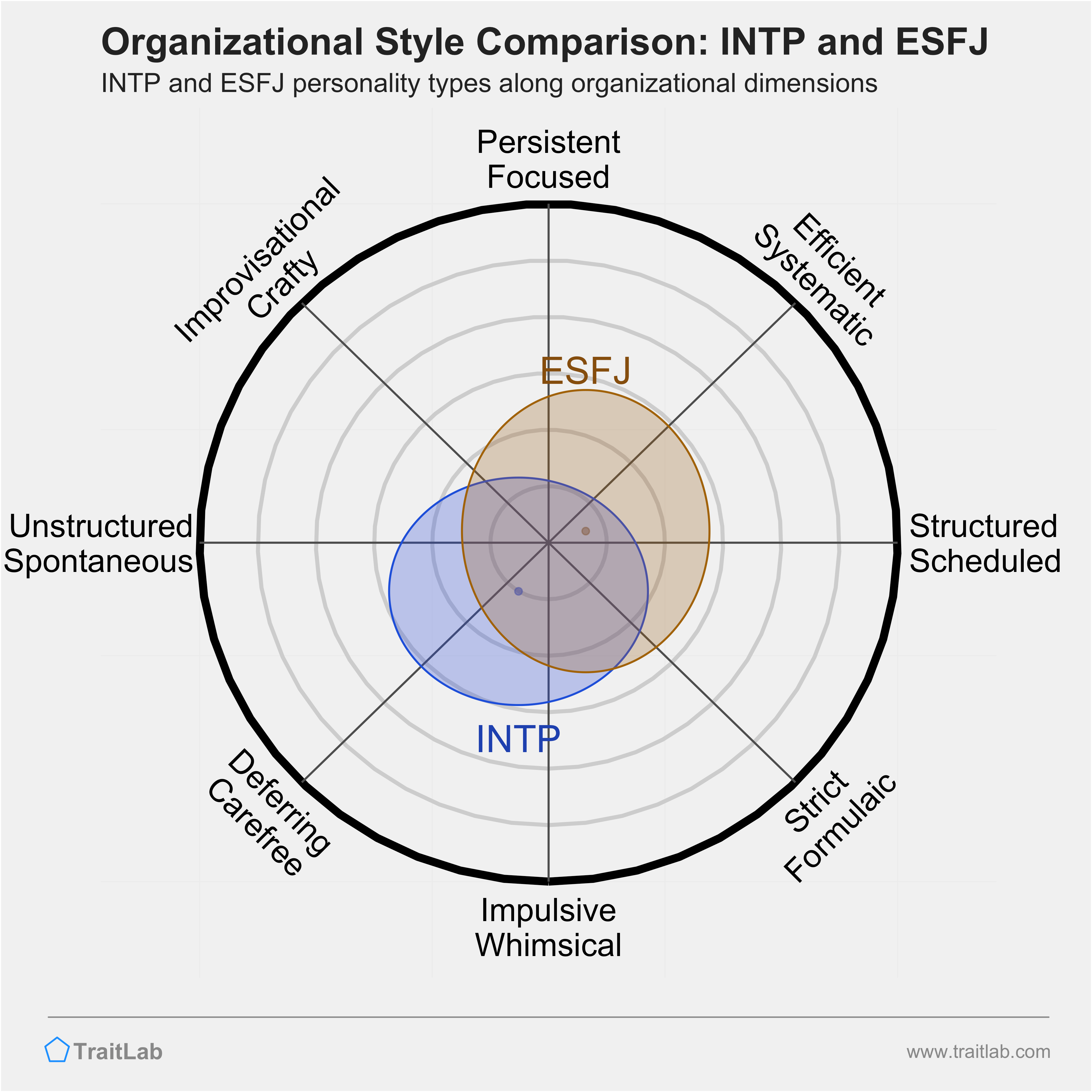How compatible are INTP and ESFJ patterns of communicating, thinking, and working?
Reading time: 5 minutes

Gregory Park, Ph.D.
Author
In this article, you’ll find a comparison of INTPs and ESFJs across five important personality domains: Interpersonal/Communication Style, Emotional Style, Intellectual Style, and Organizational Style.
One important note: the following comparisons cannot be made simply by comparing the cognitive functions (letters) of each personality type.
For this analysis, TraitLab gathered data about personality traits from thousands of participants who identified themselves as a particular type in the 16 Personality or Myers-Briggs framework.
The comparisons here show the average similarities and differences between INTPs and ESFJs. However, remember that all personality types are oversimplifications. For an assessment of your unique position in these areas, you’ll need a personalized assessment that doesn’t rely on personality types.
Jump to any section with the links below.

Do you know your personality type?
Learn about your type and so much more with TraitLab's comprehensive personality assessment.
Your particular style of communicating and interacting with others can be described fairly well by two dimensions: assertiveness and warmth.
Assertiveness describes your tendency to assert yourself, lead, and influence others in social situations, while warmth describes your tendencies to empathize and put others’ needs ahead of your own.
People with the same personality type often share some similarities in assertiveness and warmth. In the graph below, you can see where most INTPs and most ESFJs fall along both of these dimensions.
First, take a look at where people in each type, on average, fall in this interpersonal space.

INTPs are realists who perceive things and people clearly, without being overly optimistic. At their best, they are practical skeptics who are comfortable holding and sharing unorthodox, unpopular views. INTPs may be overly skeptical and suspicious, and they may have difficulty trusting others. At their worst, they can struggle to make new friends and socialize, and have a hard time showing affection and admiration for others.
ESFJs often agree, trust, and cooperate with others. At their best, they are friendly, affectionate, and bring out the warmth and sympathy in others. ESFJs may be too agreeable and quick to compromise. At their worst, they may seek approval and agreement too much, and be dependent on the approval of other people.
As an INTP, one notable difference between you and most ESFJs is in your interpersonal warmth. You are likely on the colder, more combative side of the spectrum. Compared to you and other INTPs, ESFJs’ can sometimes feel overly focused on feelings and intentions, rather than the facts of the matter at hand.
However, you and most ESFJs both tend to be on the more reserved and passive side in social situations. On one hand, this is a benefit: both of you tend to be reliable partners, ready and willing to help each other when needed. On the other hand, your mutual passivity can stall decisions and action, especially if both of you are waiting for the other to take the lead.
Another characteristic of your personality is your emotional style — your tendencies towards different kinds of moods. There are two dimensions that influence emotional style: arousal and valence.
Arousal describes your relative energy level across different situations. Those with high baseline levels of arousal tend to be generally more alert, active, and engaged, while those with a lower baseline are more reserved, subdued, and inhibited.
Valence describes whether these moods tend to be positive (pleasant) or negative (unpleasant). People with a more positively valenced style are more likely to experience emotions like joy, enthusiasm, satisfaction, and serenity. People with a more negatively valenced style are more likely to experience sadness, frustration, dissatisfaction, and anxiety.
The graph below shows where each type, on average, usually sits in this emotional space.

INTPs have a tendency to be quiet and inhibited. Compared to most people, they can easily drift into gloom and melancholy. They see the glass as half-empty and have a more skeptical outlook and a hesitant approach to life. For better or worse, INTPs tend to notice the negatives in most situations. In stressful times, they are more likely to withdraw quietly and retreat inward, rather than share their frustration with others.
ESFJs tend to be energetic and enthusiastic across most situations. They take on new challenges with excitement, confidence, and a sense of adventure. ESFJs are usually more optimistic than most people, and they generally feel like they can handle what life throws at them.
As with most INTPs, you tend to be more reserved, inhibited, and quiet than most ESFJs. Between the two of you, you are more likely to need more personal space, solitude, and time to decompress. While you can tolerate long periods of calm and quiet, your ESFJ counterparts often craves more engagement and excitement. In the best cases, an ESFJ can pull you out of your comfort zone and get you out into the world, while your quiet nature helps to balance out their intensity.
Another difference between INTPs and ESFJs in their typical emotional valence, or their tendencies towards positive and negative emotions. You and most INTPs tend to fall on the more negative side. Compared to most ESFJs, you and most INTPs typically experience more negative emotions like sadness, worry, frustration, and impatience. ESFJs have the opposite pattern, and they tend to gravitate toward positive emotions like enthusiasm, joy, and contentment.
These emotional differences can be subtle, but they may color how INTPs and ESFJs process new information. You and most INTPs are quicker to see the negatives and consider what could go wrong, while ESFJs might receive the same news with excitement and optimism.
Your intellectual style describes how you receive, process, and pursue different kinds of information. Differences in intellectual style are captured well by two dimensions: ideas and aesthetics.
Ideas describes your appetite for new information and your interest in complex, challenging material. People high on the ideas dimension have an appreciation for complexity and technical details. People lower on ideas are less interested in learning for learning’s sake, and they prefer to simplify complex topics down to the essential details.
Aesthetics captures your relative interest and sensitivity to aesthetic information and its emotional impact. People higher on the aesthetics dimension usually have strong artistic interests and a deep appreciation for beauty in many forms. Those lower on aesthetics tend to value practical application over artistic merit and usually adhere to more conventional standards of beauty.
In the graph below, you’ll see where INTPs and ESFJs, on average, fall in this intellectual space.

INTPs are usually highly effective, efficient thinkers, capable of processing large amounts of complex information and distilling it down to its most useful elements. They are pragmatic and grounded and prefer to apply their knowledge to conventional, practical pursuits.
ESFJs are practical realists. They focus on building practical skills and essential knowledge and are less likely to spend time learning for learning’s sake. In addition, they usually value conventional, tangible accomplishments over artistic expression and rarely feel compelled to develop a creative outlet.
As with many INTPs, you tend to have a stronger need for information and complexity than most ESFJs. You are much more likely to become enamored with a fascinating new idea and dive head first into learning everything you can about it while your ESFJ counterparts are focused on the practical matter in front of them. You may find yourself pulling the conversation to a more theoretical level when you’re together, while your ESFJ partner resists and keeps things down-to-earth.
Likewise, INTPs and ESFJs share an appreciation for practical, tangible accomplishments over artistic expression. INTPs and ESFJs are both likely to embrace conventional ways of thinking, and both types are more skeptical of eccentric or unusual approaches to solving problems.
Your organizational style describes your habits around organization and planning. Your organizational style influences how you structure your time and physical space. Differences in organizational style fall along two dimensions: industriousness and orderliness.
Industriousness describes your persistence, need for achievement, and intensity of focus. People higher on industriousness usually organize their behavior around a few important long-term goals. People lower on industriousness are usually more focused on the present and will more easily change their focus when new opportunities appear.
Orderliness describes your need for regularity, order, and structure in your environment. People higher on orderliness prefer tidy, organized physical spaces, detailed schedules, and reliable routines. People lower on orderliness can tolerate more disorganization and prefer a more spontaneous, unstructured approach.
The graph below shows the average position of INTPs and ESFJs along these dimensions of organizational style.

INTPs thrive in unstructured environments with fewer constraints and more room for improvisation and serendipity. They generally focus on enjoying the present rather than preparing for the future. INTPs highly value spontaneity and the flexibility to change their mind, and they resist setting hard deadlines or rigid expectations.
ESFJs are usually systematic and highly organized. They like setting big, long-term goals and then creating detailed plans to accomplish them. ESFJs are generally good at ignoring distractions and making steady progress through consistent routines and habits.
Like many INTPs, you and most ESFJ often differ in your need to achieve explicit goals and use your time productively. While you embrace the here and now, your ESFJ counterpart is often thinking about and planning for the future. When you are keeping your eyes out for new, interesting opportunities, ESFJs are usually working away with their heads down. This difference between your present-oriented mindset and their future-oriented one can create occasional tension. However, this difference also helps you balance the other out at times. Your ESFJ counterpart often needs you to break them out of their need for productivity and efficiency while they can provide you with additional focus and motivation.
A second difference between INTPs and ESFJs is in their relative need for routine, structure, and order. You and most INTPs are more comfortable with an unplanned, spontaneous approach to life, while your ESFJ counterpart often wants plans, schedules, and well-defined procedures. ESFJs thrive on routine and predictability, whereas INTPs find the same level of organization to be overbearing and constraining. These differences in tidiness, punctuality, and comfortability with deviating from social expectations can be a consistent source of conflict between the two of you.
Most people have complex personalities and don’t fall into a single personality type.
With TraitLab’s comprehensive analyses of your traits, strengths, and interests, you can see how your personality compares to all 16 types. Start building your personality profile by creating a free account today.
For comparisons between INTPs and other types from the 16 Personality typology, visit any of the type pairings below:
For comparisons between INTPs and other Enneagram types, visit any of the type pairings below: